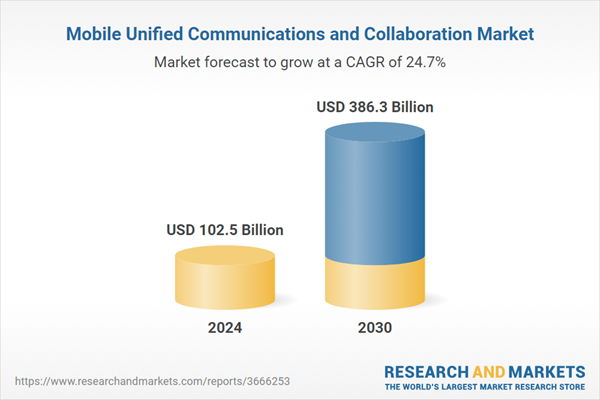The global market for Mobile Unified Communications and Collaboration was valued at US$102.5 Billion in 2024 and is projected to reach US$386.3 Billion by 2030, growing at a CAGR of 24.7% from 2024 to 2030. This comprehensive report provides an in-depth analysis of market trends, drivers, and forecasts, helping you make informed business decisions. The report includes the most recent global tariff developments and how they impact the Mobile Unified Communications and Collaboration market.
Integrating mobile UC systems presents unique challenges and opportunities, particularly in harmonizing these systems with existing UC platforms and personal devices used for business communications. Issues such as the poor quality of VoIP services over mobile networks often deter full adoption. Yet, the opportunity to use personal or company-owned mobile phones as standard communication endpoints on cloud UC platforms offers a high-quality, convenient solution that enhances user experience and operational efficiency. This integration not only streamlines communication by reducing the need to manage multiple devices but also improves customer relations and data security for businesses. For example, dual SIM capabilities can separate personal and business communications on the same device, safeguarding business contacts and ensuring continuity in customer relationships, which is vital for maintaining corporate communication integrity and customer satisfaction.
The growth of mobile UC is driven by several key factors. Integration with enterprise applications like CRM systems enhances the usability and functionality of mobile UC platforms, making daily tasks more efficient for users and driving adoption. Advances in network infrastructure, particularly the rollout of 5G, improve the reliability and quality of these services, making mobile UC more attractive to organizations that demand robust communication capabilities. The rise of remote and hybrid work models has created a necessity for effective communication tools that support a geographically dispersed workforce, further accelerating the demand for mobile UC solutions. Additionally, the push for cost-effective communication solutions encourages businesses to reduce expenditures on traditional communication hardware, opting for mobile UC solutions that provide seamless communication experiences across multiple devices and platforms. Regulatory requirements for data security and privacy also propel organizations towards these advanced solutions. Finally, the environmental sustainability offered by mobile UC, reducing the need for physical travel and communication hardware, aligns with corporate goals to decrease carbon footprints, adding to the compelling reasons for its adoption in modern business practices.
Segments: Type (On-Premise, Hosted); Vertical (Enterprise, Government, Healthcare, Education, Other Verticals).
Geographic Regions/Countries: World; United States; Canada; Japan; China; Europe (France; Germany; Italy; United Kingdom; and Rest of Europe); Asia-Pacific; Rest of World.
The analysts continuously track trade developments worldwide, drawing insights from leading global economists and over 200 industry and policy institutions, including think tanks, trade organizations, and national economic advisory bodies. This intelligence is integrated into forecasting models to provide timely, data-driven analysis of emerging risks and opportunities.
Global Mobile Unified Communications and Collaboration Market - Key Trends and Drivers Summarized
Mobile Unified Communications and Collaboration (UC&C) are reshaping global business practices by enhancing connectivity and collaboration, enabling employees to communicate effectively regardless of location. This evolution in communication technology integrates voice, data, and video, transitioning from traditional voice-centric methods to comprehensive, data-driven communication platforms that incorporate email, instant messaging, and video conferencing. Such advancements facilitate a dynamic working environment, essential in today's digital economy. In particular, mobile UC solutions are becoming indispensable for businesses, driven by changes in work practices due to the pandemic and the continuous shift towards digital transformation. These solutions are designed to be scalable, supporting seamless communication across various geographical locations and platforms, crucial for large organizations and indispensable for small and medium-sized businesses (SMBs) that require cost-effective, flexible communication tools.Integrating mobile UC systems presents unique challenges and opportunities, particularly in harmonizing these systems with existing UC platforms and personal devices used for business communications. Issues such as the poor quality of VoIP services over mobile networks often deter full adoption. Yet, the opportunity to use personal or company-owned mobile phones as standard communication endpoints on cloud UC platforms offers a high-quality, convenient solution that enhances user experience and operational efficiency. This integration not only streamlines communication by reducing the need to manage multiple devices but also improves customer relations and data security for businesses. For example, dual SIM capabilities can separate personal and business communications on the same device, safeguarding business contacts and ensuring continuity in customer relationships, which is vital for maintaining corporate communication integrity and customer satisfaction.
The growth of mobile UC is driven by several key factors. Integration with enterprise applications like CRM systems enhances the usability and functionality of mobile UC platforms, making daily tasks more efficient for users and driving adoption. Advances in network infrastructure, particularly the rollout of 5G, improve the reliability and quality of these services, making mobile UC more attractive to organizations that demand robust communication capabilities. The rise of remote and hybrid work models has created a necessity for effective communication tools that support a geographically dispersed workforce, further accelerating the demand for mobile UC solutions. Additionally, the push for cost-effective communication solutions encourages businesses to reduce expenditures on traditional communication hardware, opting for mobile UC solutions that provide seamless communication experiences across multiple devices and platforms. Regulatory requirements for data security and privacy also propel organizations towards these advanced solutions. Finally, the environmental sustainability offered by mobile UC, reducing the need for physical travel and communication hardware, aligns with corporate goals to decrease carbon footprints, adding to the compelling reasons for its adoption in modern business practices.
Report Scope
The report analyzes the Mobile Unified Communications and Collaboration market, presented in terms of units. The analysis covers the key segments and geographic regions outlined below.Segments: Type (On-Premise, Hosted); Vertical (Enterprise, Government, Healthcare, Education, Other Verticals).
Geographic Regions/Countries: World; United States; Canada; Japan; China; Europe (France; Germany; Italy; United Kingdom; and Rest of Europe); Asia-Pacific; Rest of World.
Key Insights:
- Market Growth: Understand the significant growth trajectory of the On-Premise segment, which is expected to reach US$167.8 Billion by 2030 with a CAGR of a 22.2%. The Hosted segment is also set to grow at 27.0% CAGR over the analysis period.
- Regional Analysis: Gain insights into the U.S. market, valued at $30.0 Billion in 2024, and China, forecasted to grow at an impressive 24.0% CAGR to reach $59.2 Billion by 2030. Discover growth trends in other key regions, including Japan, Canada, Germany, and the Asia-Pacific.
Why You Should Buy This Report:
- Detailed Market Analysis: Access a thorough analysis of the Global Mobile Unified Communications and Collaboration Market, covering all major geographic regions and market segments.
- Competitive Insights: Get an overview of the competitive landscape, including the market presence of major players across different geographies.
- Future Trends and Drivers: Understand the key trends and drivers shaping the future of the Global Mobile Unified Communications and Collaboration Market.
- Actionable Insights: Benefit from actionable insights that can help you identify new revenue opportunities and make strategic business decisions.
Key Questions Answered:
- How is the Global Mobile Unified Communications and Collaboration Market expected to evolve by 2030?
- What are the main drivers and restraints affecting the market?
- Which market segments will grow the most over the forecast period?
- How will market shares for different regions and segments change by 2030?
- Who are the leading players in the market, and what are their prospects?
Report Features:
- Comprehensive Market Data: Independent analysis of annual sales and market forecasts in US$ Million from 2024 to 2030.
- In-Depth Regional Analysis: Detailed insights into key markets, including the U.S., China, Japan, Canada, Europe, Asia-Pacific, Latin America, Middle East, and Africa.
- Company Profiles: Coverage of players such as Avaya Inc., Broadsoft Inc., Cisco Systems Inc., Damaka Inc., Digium Inc. and more.
- Complimentary Updates: Receive free report updates for one year to keep you informed of the latest market developments.
Some of the 77 companies featured in this Mobile Unified Communications and Collaboration market report include:
- Avaya Inc.
- Broadsoft Inc.
- Cisco Systems Inc.
- Damaka Inc.
- Digium Inc.
- Huawei Technologies Co. Ltd.
- IBM Corp.
- Microsoft Corp.
- Mitel
- Mobisma AB
- NEC Corporation of America
- Nokia Networks
- Ribbon Communications Inc.
- Unify Inc.
- Verizon Enterprise Solutions
- XO Communications
Tariff Impact Analysis: Key Insights for 2025
Global tariff negotiations across 180+ countries are reshaping supply chains, costs, and competitiveness. This report reflects the latest developments as of April 2025 and incorporates forward-looking insights into the market outlook.The analysts continuously track trade developments worldwide, drawing insights from leading global economists and over 200 industry and policy institutions, including think tanks, trade organizations, and national economic advisory bodies. This intelligence is integrated into forecasting models to provide timely, data-driven analysis of emerging risks and opportunities.
What’s Included in This Edition:
- Tariff-adjusted market forecasts by region and segment
- Analysis of cost and supply chain implications by sourcing and trade exposure
- Strategic insights into geographic shifts
Buyers receive a free July 2025 update with:
- Finalized tariff impacts and new trade agreement effects
- Updated projections reflecting global sourcing and cost shifts
- Expanded country-specific coverage across the industry
Table of Contents
I. METHODOLOGYII. EXECUTIVE SUMMARY2. FOCUS ON SELECT PLAYERSIII. MARKET ANALYSISIV. COMPETITION
1. MARKET OVERVIEW
3. MARKET TRENDS & DRIVERS
4. GLOBAL MARKET PERSPECTIVE
UNITED STATES
CANADA
JAPAN
CHINA
EUROPE
FRANCE
GERMANY
ITALY
UNITED KINGDOM
REST OF EUROPE
ASIA-PACIFIC
REST OF WORLD
Companies Mentioned (Partial List)
A selection of companies mentioned in this report includes, but is not limited to:
- Avaya Inc.
- Broadsoft Inc.
- Cisco Systems Inc.
- Damaka Inc.
- Digium Inc.
- Huawei Technologies Co. Ltd.
- IBM Corp.
- Microsoft Corp.
- Mitel
- Mobisma AB
- NEC Corporation of America
- Nokia Networks
- Ribbon Communications Inc.
- Unify Inc.
- Verizon Enterprise Solutions
- XO Communications
Table Information
| Report Attribute | Details |
|---|---|
| No. of Pages | 213 |
| Published | April 2025 |
| Forecast Period | 2024 - 2030 |
| Estimated Market Value ( USD | $ 102.5 Billion |
| Forecasted Market Value ( USD | $ 386.3 Billion |
| Compound Annual Growth Rate | 24.7% |
| Regions Covered | Global |









